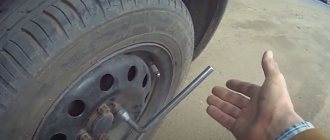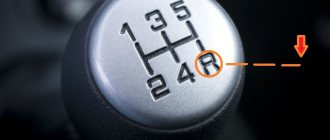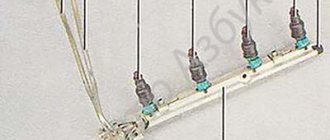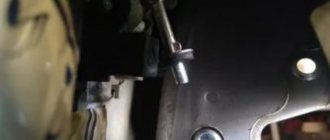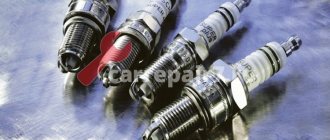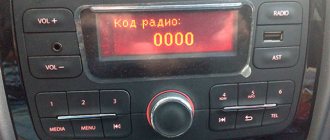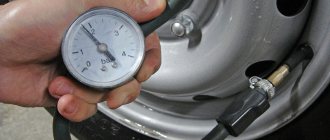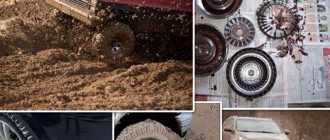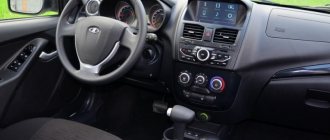When the thorns have already been ground down...
- Elementary, atson! On summer tires it always skids in winter...
Professional tire fitters say: winter wheels on every third car in Russia have long ago turned into summer wheels. And they behave accordingly on the ice.
And all because of our man’s sincere confidence that you need to buy “winter shoes” for a four-wheeled horse no more often than you need to change the car itself.
To understand how much winter tires are left, let’s take a close look at the cylinders that have been gathering dust for six months in the garage.
Test for the Schumachers
The easiest way to determine whether the tires will last through another winter is to wait for the first black ice. Drive out onto a flat section of the road or yard, draw a line on the ice and, accelerating to 40 - 50 km per hour, try to stop in front of it. You may not succeed the first time, but you will gain invaluable experience - you will immediately remember how much longer the braking distance is in winter. And at the same time, use the brake mark to determine whether you need to pull on the tires.
We determine wear by eye
There should be no deep cuts, cracks (indicating old age of the rubber), bubbles (hernias), protruding threads or metal wires on the cord structure on the tread and sidewall of a still “living” tire. If any of the above deficiencies are identified, the wheel must be thrown away without regret.
Don't forget to inspect the tread surface. It often gets clogged with road debris and needs to be removed. You need to pay special attention to nails and sharp pieces of metal, the release of which can lead to a sharp drop in tire pressure and, as a consequence, to a sharp deterioration in the car’s handling.
If the tires are studded, look to see how many studs are left on it. A loss of 5-10 percent of studs in one season of operation is an ideal indicator, but in any case, winter tires rarely last longer than 4 years.
If a tire has lost 30-50 percent of its teeth over the course of a season, most likely you did not use it correctly or the tires were studded without following technology.
Look at the sockets from which the spikes have come out: if they are even, round in shape, it means that the tire was studded by a non-specialist, and if the hole from the spike looks more like an asterisk, it means that you urgently need to change your driving style.
By the way, all foreign-made tires, no matter what they tell you, are studded in Russia.
It is better to re-stud a tire that has lost its “claws” only in a very good tire shop, where a self-respecting master will definitely tell you whether it is worth doing it at all. In garages, of course, they will stud your tires without any questions asked, but the main criterion for making this decision will be your money, and not your professional reputation!
If the tire has lost its studs, but the tread depth is still decent, it will in any case hold the road better than a summer or so-called all-season tire.
How to extend the life of wheels
To increase tire life, the drive wheels should be regularly swapped with the driven wheels.
Ideally, you need to switch the wheels from the front to the rear and vice versa every 5 - 10 thousand kilometers. In this case, the tires will wear out evenly and, if used correctly, will last for 4 years.
If you are too lazy to change wheels, come to terms with the idea that in a couple of winters you will have two wheels that are almost completely worn out, and two that are almost new.
Extend the life of wheels and use two sets of rims. Each re-beading of rubber significantly reduces its service life. It is especially dangerous to change wheels in garage tire shops.
They often skimp on special mounting pastes, as a result of which the tire bead ring breaks when the wheel is beaded. After which the wheel stops holding air and must be constantly pumped up.
From winter to summer
After four winters or when the tire tread wears 50%, winter tires often turn into summer tires. At this point, the sipes (grooves on the rubber) are almost completely erased and the traction characteristics of the tires disappear.
You can’t ride them in winter, but in summer you can.
How to store tires
Tires can be stored in any position. In a dark place, at room temperature. At first glance, nothing special, but creating such greenhouse conditions at home is very difficult. Tires are like a box of matches; you can’t hide them in a table.
If finances allow, it is best to entrust the wheels to specialists. Many specialized services today accept wheels for seasonal storage. The pleasure is not cheap - it costs up to 20 rubles a day. But after six months, many do not recognize their wheels, which are not only washed before storage, but also treated with a special silicone, which gives even a fairly worn tire the appearance of a new wheel and prevents the aging of the rubber.
How to use winter tires:
Don’t start with a slip – you won’t tear up the asphalt anyway, and you’ll lose the studs on the tires.
Start braking early, use engine braking, and try not to brake until the wheels lock.
Avoid sudden maneuvers - the car may spin on ice.
Don't accelerate more than 100 km per hour - and winter tires will last you much longer.
Don't forget to inspect and balance your wheels.
What are winter Velcro?
Today, car markets sell studded tires and so-called “Velcro” tires based on the principle of frog legs. Which ones are safer to use in winter? D. Vasiliev. Armavir.
“Velcro” or “suction cups” are the name given to modern foreign-made non-studded winter tires. They owe their nickname to the large number of small multidirectional sipes (grooves) on the tread surface, which help achieve better contact with the road. When braking and maneuvering on a slippery surface, such tires literally stick to the slippery surface.
“Velcro” came to us from countries with temperate climates, where there is practically no long-term snow cover and where the use of studded tires is prohibited by law.
In the Russian climate, it is still better to use studded tires - they will pay for themselves as soon as you hit a frozen puddle while turning your wheels.
Is it possible to ride on tires if the studs have fallen out?
To answer the question whether it is possible to drive on tires on which some of the studs have fallen out, you need to understand exactly how much, as a percentage of the total number of studs, the rubber has lost. To do this, we calculate the percentage of remaining spikes using a simple formula:
100 * number of spikes remaining / total number of spikes = percentage of spikes remaining
Having obtained, after a simple calculation, the percentage of remaining studs, you can assess the suitability of the rubber for use in winter weather conditions. According to general recommendations from manufacturers, you need to focus on the following figures:
5% of spikes dropped. Good result even for new tires. Often 5% of the studs are lost during transport of tires. The grip properties of such a tire do not suffer much.- 10% of the spikes have fallen out. This type of tire is suitable for use, often 10% of the studs are lost in the first two seasons. The loss in grip properties on such tires is minimal.
- 20% of the spikes have fallen out. Normal wear and tear for tires that have been in use for about 3 years. You can continue driving on these tires in winter.
- 30%-40% of thorns fell out. Studded tires with medium wear. The grip properties of such a tire with the road are noticeably reduced. The braking distance on such tires will increase slightly compared to a new tire, and the car will behave less confidently at high speeds when cornering. But manufacturers still allow the use of such tires.
- 50%-60% of the thorns fell out. The rubber is heavily worn and is recommended to be used only as a last resort. In this case, tires with such wear can only be installed on the driven axle of the car; more “live” tires should be on the drive axle.
- More than 60% of the thorns have fallen out. You cannot drive a car on tires that have lost more than 60% of their studs. The grip properties of such tires with the road are reduced, and the behavior of a car on such tires is unpredictable.
It is important to remember the rule that the most worn tires must be installed on the driven axle. It is recommended to count the studs before “changing shoes” in order to determine the less and more damaged tires.
( 406 votes, average: 4.48 out of 5)
How to choose used tires that will last for several seasons?
A self-tapping screw got into a wheel: what to do?
Related Posts
Rating of the best winter tires based on general parameters
Which tires are in our top best solutions for winter? Below are presented only the highest quality options, which are not only recommended by experts, but also by experienced car owners.
Bridgestone Blizzak Ice
| Country: Japan Brand: Bridgestone Price: 6760 rubles Rating: 5 |
Description
These “Velcro” from the famous Japanese company are distinguished by high wear resistance and directional stability. Among other advantages, it is worth noting effective braking. Bridgestone tread pattern is asymmetrical, due to which the noise level is lower than that of competitors.
No less attractive is the upgraded rubber compound, which makes the rigidity in the outer layer optimal for winter. This solution without spikes, which is considered the best among Velcro for 2019-2020, provides the car with ideal cross-country ability.
Pros:
- reliability;
- low noise level;
- high wear resistance;
- excellent handling, including on ice;
- good drainage.
Minuses:
shallow tread, often clogged with snow.
Reviews
Alexander: “Control in any mode, braking on ice, almost silent.”
Alexey: “Excellent Velcro, in any driving mode, in any weather conditions, even on snow, even on wet and dry asphalt. When maneuvering sharply, the car does not yaw and follows a clearly defined trajectory.”
Yokohama Ice Guard IG60
| Country: Japan Brand: Yokohama Price: 5050 rubles Rating: 5 |
Description
Another solution for passenger cars, which can be safely called ideal in all respects. The presented version, produced by a popular brand, is distinguished by a thoughtful tread pattern. Thanks to this, there are no problems with water drainage during periods of temperature changes, which are not uncommon in Russian realities. The fine-bubble outer layer makes these tires comfortable to ride. They do not “freeze”, hold the car well on the road and maintain an optimal level of softness.
Pros:
- optimal grip on asphalt and ice;
- excellent maneuverability;
- reliability;
- reasonable price.
Minuses:
average wear resistance.
Reviews
Mikhail: “I braked a couple of times on frozen asphalt, very slippery. But everything worked! There was no feeling that it was leading, but there was a hook. Roughness plays a role.”
Average number of spikes
The number of studs varies depending on the type and radius of the tire. However, an increase in the radius does not lead to a direct increase in their number, but fluctuates approximately within the same limit. Let's take a closer look at tires with radii r13, r14, r15, r16, r17 and r18.
Tires r13
One of the most budget-friendly r13 tires has a number of studs of around 110 pieces. For example, the Nokian Nordman 5 can boast of this number.
Tires r14
The most popular tires at the moment, most often installed on domestic cars. Tires with a radius of r14 also have about 110 studs . Nokian 4 and Cordiant Polar 2 have so many of them. But Kama Euro 519 has 112 pieces, Nokian Hakapellita 8 has 165, and Gislaved Nord Fros has only 90.
Tires r15
The r 15 model is used in most, even the most budget-friendly, foreign cars; it also has about 110 pieces (like the Cordiant Snow Cross).
Tires r16
The larger version, the very popular radius r 16 today, most often has 108 pieces , but there are also more, for example, Nordman 4 and Pirelli Ice Zero - 130 pieces, Nordman 7 - 128, and Nokian Hakapelita 9 - 172.
Tires r17
But the size of the r17 is already significantly different from the previous ones - in its arsenal there are as many as 130 pieces , for example, the Nordman 5 has so many of them.
Tires r18
On average, 18-radius tires are equipped with only 100 pieces.
We can conclude that the size of the wheel does not greatly affect the number of studs in the tire . Even in models with a radius of r17 or r18 there are slightly more of them. The main thing is the quality of installation of the studs, their shape, as well as the quality properties of the rubber itself.

